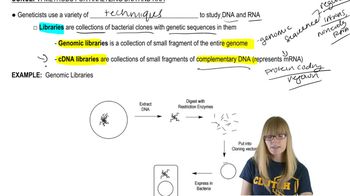Compare and contrast the terms Paternity Index (PI) and Combined Paternity Index (CPI). How does each contribute to paternity determination?
Table of contents
- 1. Introduction to Genetics51m
- 2. Mendel's Laws of Inheritance3h 37m
- 3. Extensions to Mendelian Inheritance2h 41m
- 4. Genetic Mapping and Linkage2h 28m
- 5. Genetics of Bacteria and Viruses1h 21m
- 6. Chromosomal Variation1h 48m
- 7. DNA and Chromosome Structure56m
- 8. DNA Replication1h 10m
- 9. Mitosis and Meiosis1h 34m
- 10. Transcription1h 0m
- 11. Translation58m
- 12. Gene Regulation in Prokaryotes1h 19m
- 13. Gene Regulation in Eukaryotes44m
- 14. Genetic Control of Development44m
- 15. Genomes and Genomics1h 50m
- 16. Transposable Elements47m
- 17. Mutation, Repair, and Recombination1h 6m
- 18. Molecular Genetic Tools19m
- 19. Cancer Genetics29m
- 20. Quantitative Genetics1h 26m
- 21. Population Genetics50m
- 22. Evolutionary Genetics29m
18. Molecular Genetic Tools
Methods for Analyzing DNA
Problem 4b
Textbook Question
You have constructed four different libraries: a genomic library made from DNA isolated from human brain tissue, a genomic library made from DNA isolated from human muscle tissue, a human brain cDNA library, and a human muscle cDNA library.
Would the sequences contained in each library be expected to overlap completely, partially, or not at all with the sequences present in each of the other libraries?
 Verified step by step guidance
Verified step by step guidance1
Understand the difference between genomic libraries and cDNA libraries: Genomic libraries contain DNA sequences representing the entire genome of an organism, including both coding (exons) and non-coding regions (introns, regulatory sequences, etc.). cDNA libraries, on the other hand, are constructed from mRNA and represent only the expressed genes (coding regions) in a specific tissue at a specific time.
Consider the genomic libraries: Since both the human brain genomic library and the human muscle genomic library are derived from the entire genome, they will contain identical sequences. The genome is the same across all tissues, so these libraries will overlap completely.
Analyze the cDNA libraries: The human brain cDNA library and the human muscle cDNA library are derived from mRNA, which reflects the genes actively expressed in each tissue. Different tissues express different sets of genes, so these libraries will overlap partially, as some genes are expressed in both tissues while others are tissue-specific.
Compare genomic libraries to cDNA libraries: Genomic libraries contain all DNA sequences, while cDNA libraries contain only expressed genes. Therefore, the sequences in genomic libraries will overlap partially with those in cDNA libraries, as cDNA libraries represent a subset of the genome (the expressed genes).
Summarize the relationships: The human brain genomic library and human muscle genomic library overlap completely. The human brain cDNA library and human muscle cDNA library overlap partially. Genomic libraries overlap partially with cDNA libraries because cDNA libraries represent only the expressed genes in specific tissues.
 Verified video answer for a similar problem:
Verified video answer for a similar problem:This video solution was recommended by our tutors as helpful for the problem above
Video duration:
5mPlay a video:
Was this helpful?
Key Concepts
Here are the essential concepts you must grasp in order to answer the question correctly.
Genomic Library
A genomic library is a collection of DNA fragments that represent the entire genome of an organism. It includes both coding (exons) and non-coding (introns) regions of DNA. Libraries constructed from different tissues may contain overlapping sequences, but the extent of overlap depends on the tissue-specific expression of genes and the presence of non-coding regions.
Recommended video:
Guided course

Genomics Overview
cDNA Library
A cDNA library is created from complementary DNA synthesized from mRNA transcripts, representing only the expressed genes in a specific tissue at a given time. Since cDNA libraries are tissue-specific, the sequences in a brain cDNA library will differ from those in a muscle cDNA library, reflecting the unique gene expression profiles of each tissue.
Recommended video:
Guided course

Methods for Analyzing DNA and RNA
Gene Expression
Gene expression refers to the process by which information from a gene is used to synthesize functional gene products, typically proteins. Different tissues express different sets of genes based on their specific functions, leading to variations in the sequences found in genomic and cDNA libraries. This results in partial overlap between libraries derived from different tissues.
Recommended video:
Guided course

Penetrance and Expressivity

 7:40m
7:40mWatch next
Master Methods for Analyzing DNA and RNA with a bite sized video explanation from Kylia
Start learningRelated Videos
Related Practice
Textbook Question
440
views
